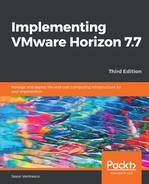The following resources represent a starting point for assigning CPU and RAM resources to Microsoft RDS servers. The actual resources that are required will vary based on the applications being used, and the number of concurrent users, so it is important to monitor server utilization and adjust the CPU and RAM specifications if required. The following are the recommended requirements:
- Four vCPUs to support a maximum of 50 RDS sessions (per server).
- 24 GB RAM
-
A minimum of 40 GB hard disk space for the RDS server itself, plus sufficient hard drive space to store RDS user profiles (if storing locally). Consider one of the following options to help better manage user profiles:
- VMware User Environment Manager (UEM) may be used to manage profiles for users of Horizon application pools; refer to Chapter 12, Implementing VMware User Environment Manager, and the UEM documentation (https://docs.vmware.com/en/VMware-User-Environment-Manager/index.html) for further details.
- Horizon Persona Management, which is not discussed in this book, is not supported for use with Microsoft RDS servers. Even if it were, owing to its more advanced capabilities, UEM is a better choice for user-profile management.
- Microsoft RDS includes multiple native options to control user-profile configuration and growth, including a RD user home directory, RD roaming user profiles, and mandatory profiles. For information about these and other options, consult the Windows IT Pro Center article, Folder Redirection, Offline Files, and Roaming User Profiles overview (https://docs.microsoft.com/en-us/windows-server/storage/folder-redirection/folder-redirection-rup-overview).
While the vCPU and RAM requirements might seem excessive at first, remember that to deploy a virtual desktop for each of these 50 users, we would need a bare minimum of 50 vCPUs, 100 GB of RAM, and 2 TB of hard disk space, which is much more than our single Microsoft RDS host requires.
By default, Horizon allows unlimited RDS user sessions for each Microsoft RDS host in the farm. Based on the RDS server specification provided, we will need to deploy multiple RDS servers if we anticipate having more than 50 connections, plus additional hosts for redundancy purposes. It is recommended that you set the default sizing to 50 as that is what recommended RDS server configuration has been optimized for.
